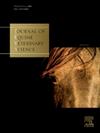Effects of sample storage time and temperature on equine complete blood counts
IF 1.6
3区 农林科学
Q2 VETERINARY SCIENCES
引用次数: 0
Abstract
Routine veterinary care often involves complete blood counts (CBC) to monitor equine health. Blood samples are often collected in unregulated, distant environments and must be stored for later analysis. While impacts of storage methods on CBC parameters have been studied in humans, there is a lack of research in horses. This study aimed to determine how blood sample storage methods influence CBC parameters. The hypothesis of this study was that key factors in hematology sample storage, namely temperature and time elapsed from collection to analysis, affect CBC parameters. Blood samples were collected from 10 healthy Quarter Horse mares (age: 13 ± 4.5 yr) and stored in EDTA tubes at room temperature (22°C), refrigerated (4°C), above ice (8°C), or in contact with ice (2°C). The IDEXX ProcyteDx was used to obtain CBCs at 3, 6, 12, 24, 48, and 72 h after collection. Data were analyzed using the Kruskal-Wallis test with Dunn's post hoc analysis and Benjamini-Hochberg correction for multiple comparisons. Significance was set to P < 0.05. Hematocrit increased in all treatments by 2% by 48 h (P < 0.01). Mean corpuscular volume increased in all treatments by 2 to 3 fL by 48 h (P < 0.01). Red blood cell distribution width increased by 2% to 3% by 48 h in all treatments (P < 0.01) and was overall 2% lower at 22°C compared with all other storage temperatures (P < 0.01). Platelet count did not change over time at 22°C but increased by 205 to 217 K/µL by 72 h at 8°C (P < 0.01), 232 to 259 K/µL by 72 h at 4°C, and 66 to 67 K/µL by 24 h at 2°C (P < 0.01). Mean corpuscular hemoglobin concentration decreased by 1 to 3 g/dL in all storage conditions by 48 h (P < 0.01), and samples kept in 22°C decreased 2 g/dL further by 72 h compared with 48 h (P < 0.01). Both the percentage and number of monocytes decreased by 1% and 0.1 K/µL, respectively, by 72 h at 22°C (P = 0.04, P = 0.01, respectively) with no changes across time points observed at other storage temperatures. Both the percentage and number of basophils were 0.3% to 0.4% and 0.03 to 0.04 K/µL higher in samples stored at 22°C compared with all other storage temperatures (P < 0.01, P < 0.01, respectively). These findings suggest that blood samples should be processed within 24 h when stored at 8°C, 4°C, or 2°C. However, storing samples at room temperature is recommended if platelet count is of primary interest. This study provides evidence to benefit CBC analysis standards of practice and emphasizes the importance of considering storage conditions when evaluating hematological parameters both in practice and research, allowing for the potential to accurately obtain CBCs in various environments.
样品储存时间和温度对马全血细胞计数的影响
常规兽医护理通常包括全血细胞计数(CBC)来监测马的健康状况。血液样本通常是在不受管制的偏远环境中收集的,必须储存起来供以后分析。虽然已经研究了储存方法对CBC参数的影响,但缺乏对马的研究。本研究旨在确定血样保存方法对CBC参数的影响。本研究的假设是血液学样本储存的关键因素,即温度和从采集到分析的时间,会影响CBC参数。采集10匹健康的四分之一马(年龄:13±4.5岁)的血液样本,保存在EDTA管中,室温(22°C)、冷藏(4°C)、冰上(8°C)或与冰接触(2°C)。在采集后3、6、12、24、48、72 h使用IDEXX ProcyteDx获得CBCs。数据分析采用Kruskal-Wallis检验,Dunn事后分析和benjamin - hochberg多重比较校正。显著性设为P <;0.05. 在48小时内,所有治疗组的红细胞压积均增加2% (P <;0.01)。在48小时内,所有治疗组的平均红细胞体积增加了2 ~ 3fl (P <;0.01)。在所有处理中,红细胞分布宽度在48小时内增加2%至3% (P <;0.01),在22°C时,与所有其他储存温度相比,总体上降低了2% (P <;0.01)。血小板计数在22°C下没有随时间变化,但在8°C下72 h增加了205至217 K/µL (P <;0.01),在4°C下72小时232至259 K/µL,在2°C下24小时66至67 K/µL (P <;0.01)。在所有储存条件下,平均红细胞血红蛋白浓度降低了1 ~ 3 g/dL (P <;0.01),在22°C中保存72 h,比48 h进一步降低2 g/dL (P <;0.01)。在22°C下保存72 h,单核细胞的百分比和数量分别下降1%和0.1 K/µL (P = 0.04,P = 0.01),在其他保存温度下各时间点未见变化。在22°C保存的样品中,嗜碱性粒细胞的百分比和数量分别比其他所有储存温度高0.3% ~ 0.4%和0.03 ~ 0.04 K/µL (P <;0.01, P <;分别为0.01)。这些发现表明,血液样本在8°C、4°C或2°C保存时应在24小时内处理。然而,如果血小板计数是主要的兴趣,建议在室温下保存样品。本研究为CBC分析标准的实践提供了证据,并强调了在实践和研究中评估血液学参数时考虑储存条件的重要性,从而有可能在各种环境中准确获得CBC。
本文章由计算机程序翻译,如有差异,请以英文原文为准。
求助全文
约1分钟内获得全文
求助全文
来源期刊

Journal of Equine Veterinary Science
农林科学-兽医学
CiteScore
2.70
自引率
7.70%
发文量
249
审稿时长
77 days
期刊介绍:
Journal of Equine Veterinary Science (JEVS) is an international publication designed for the practicing equine veterinarian, equine researcher, and other equine health care specialist. Published monthly, each issue of JEVS includes original research, reviews, case reports, short communications, and clinical techniques from leaders in the equine veterinary field, covering such topics as laminitis, reproduction, infectious disease, parasitology, behavior, podology, internal medicine, surgery and nutrition.
 求助内容:
求助内容: 应助结果提醒方式:
应助结果提醒方式:


